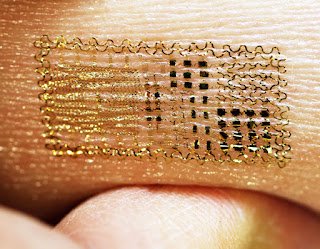by Kyle Niemeyer
Modern methods of measuring the body's activty, such as electroencephalography (EEG), electrocardiography (ECG), and electromyography (EMG), use electrical signals to measure changes in brain, heart, and muscle activity, respectively. Unfortunately, they rely on bulky and uncomfortable electrodes that are mounted using adhesive tape and conductive gel—or even needles. Because of this, these types of measurements are limited to research and hospital settings and typically used over short periods of time because the contacts can irritate skin.
 These limitations may be at an end, however. New research published in Science describes technology that allows electrical measurements (and other measurements, such as temperature and strain) using ultra-thin polymers with embedded circuit elements. These devices connect to skin without adhesives, are practically unnoticeable, and can even be attached via temporary tattoo.
These limitations may be at an end, however. New research published in Science describes technology that allows electrical measurements (and other measurements, such as temperature and strain) using ultra-thin polymers with embedded circuit elements. These devices connect to skin without adhesives, are practically unnoticeable, and can even be attached via temporary tattoo.
The authors refer to their approach as an "epidermal electronic system" (EES), which is basically a fancy way of saying that the device matches the physical properties of the skin (such as stiffness), and its thickness matches that of skin features (wrinkles, creases, etc.). In fact, it adheres to skin only using van der Waals forces—the forces of attraction between atoms and molecules—so no adhesive material is required. Between the flexibility and the lack of adhesive, you wouldn’t really notice one of these attached.
As demonstrations, the authors used their devices to measure heartbeats on the chest (ECG), muscle contractions in the leg (EMG), and alpha waves through the forehead (EEG). The results were all high quality, comparing well against traditional electrode/conductive gel measurements in the same locations. In addition, the devices continuously captured data for six hours, and the devices could be worn for a full 24 hours without any degradation or skin irritation.
One interesting demonstration that also suggests future applications was the measuring of throat muscle activity during speech. Different words showed distinctive signals, and a computer analysis enabled the authors to recognize the vocabulary being used.
Read more:
Modern methods of measuring the body's activty, such as electroencephalography (EEG), electrocardiography (ECG), and electromyography (EMG), use electrical signals to measure changes in brain, heart, and muscle activity, respectively. Unfortunately, they rely on bulky and uncomfortable electrodes that are mounted using adhesive tape and conductive gel—or even needles. Because of this, these types of measurements are limited to research and hospital settings and typically used over short periods of time because the contacts can irritate skin.
 These limitations may be at an end, however. New research published in Science describes technology that allows electrical measurements (and other measurements, such as temperature and strain) using ultra-thin polymers with embedded circuit elements. These devices connect to skin without adhesives, are practically unnoticeable, and can even be attached via temporary tattoo.
These limitations may be at an end, however. New research published in Science describes technology that allows electrical measurements (and other measurements, such as temperature and strain) using ultra-thin polymers with embedded circuit elements. These devices connect to skin without adhesives, are practically unnoticeable, and can even be attached via temporary tattoo.The authors refer to their approach as an "epidermal electronic system" (EES), which is basically a fancy way of saying that the device matches the physical properties of the skin (such as stiffness), and its thickness matches that of skin features (wrinkles, creases, etc.). In fact, it adheres to skin only using van der Waals forces—the forces of attraction between atoms and molecules—so no adhesive material is required. Between the flexibility and the lack of adhesive, you wouldn’t really notice one of these attached.
As demonstrations, the authors used their devices to measure heartbeats on the chest (ECG), muscle contractions in the leg (EMG), and alpha waves through the forehead (EEG). The results were all high quality, comparing well against traditional electrode/conductive gel measurements in the same locations. In addition, the devices continuously captured data for six hours, and the devices could be worn for a full 24 hours without any degradation or skin irritation.
One interesting demonstration that also suggests future applications was the measuring of throat muscle activity during speech. Different words showed distinctive signals, and a computer analysis enabled the authors to recognize the vocabulary being used.
Read more: